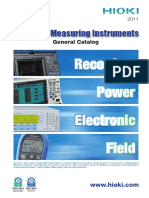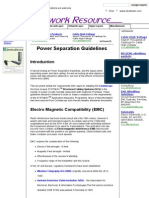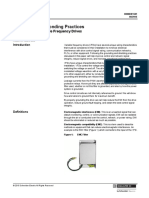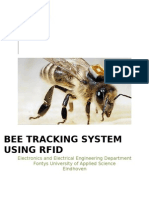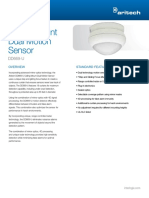Application Note 42007 Safety, EMI and RFI Considerations
Application Note 42007 Safety, EMI and RFI Considerations
Uploaded by
Mauro MarafonCopyright:
Available Formats
Application Note 42007 Safety, EMI and RFI Considerations
Application Note 42007 Safety, EMI and RFI Considerations
Uploaded by
Mauro MarafonOriginal Title
Copyright
Available Formats
Share this document
Did you find this document useful?
Is this content inappropriate?
Copyright:
Available Formats
Application Note 42007 Safety, EMI and RFI Considerations
Application Note 42007 Safety, EMI and RFI Considerations
Uploaded by
Mauro MarafonCopyright:
Available Formats
June 1996
Application Note 42007
by Daryl Sugasawara
and Jens Paetau Safety, EMI and RFI Considerations
INTRODUCTION
The filtering of conducted and radiated noise is an the United States and internationally are FCC’s Docket
intricate part of the design of a power supply or DC to DC 20780 and VDE’s 0806. One point to consider is that
converter. This Application Note addresses the origin of both, FCC and VDE standards exclude sub assemblies
generated EMI and RFI and the best ways to control them. from compliance to these rules. This is understandable
The topics discussed will be: since power supply radiation and conduction
characteristics can vary depending on different system
■ Background on Safety Agencies and Documents
level loading. Therefore the final product, where the
■ EMI filter design for higher power Switch Mode switching power supply is to be used, must also comply to
Power Supplies EMI and RFI specifications. Both agencies require
manufacturers to minimize the radiated and conducted
■ EMI sources and ways to control them interference of their equipment which is connected to the
■ PCB layout considerations AC mains and employs high frequency digital circuitry.
■ EMI and RFI Filter considerations for low power VDE has subdivided its RFI regulations into two categories
boost converters; ML4861 design example a) 0-10KHz unintentional high frequency generation
(VDE 0875, VDE 0879)
SAFETY AGENCIES AND BACKGROUND
b) 10KHz-30MHz intentional high frequency
The main objective of the national and international safety
generation (VDE 0871, VDE 0872)
regulatory agencies is to provide the user with a safe and
quality product which is not going to interfere with other The FCC includes all electronic devices which generate
electronic equipment. These safety agencies and standards signals at a rate greater than 10KHz. The FCC and VDE
are different depending on the country they originated. regulations closely follow each other. The FCC class A
Equipment manufacturers that would like to sell their specification covers business, commercial and industrial
product in these countries first need to get their product environments, while FCC B covers residential
approved by the corresponding safety agencies. Most environments only. The main difference as can be seen in
power supply manufacturers use the IEC (International figure 1 is the frequency span covered by both agencies.
Electro Technical Commission), VDE (Verband Deustcher The VDE frequency range for EMI and RFI emissions
Electrotechnik), or UL (Underwriters Laboratories) and covers a spectrum from 10KHz to 30MHz, while FCC’s
CSA (Canadian Standards Association) as their base to the frequency span covers only the range of 450KHz to
majority of the world’s safety requirements. Regarding the 30MHz.
radiated and conducted interference levels acceptable in
VDE 0871 FREQUENCY EMI FILTER DESIGN IN SWITCH MODE
100 POWER SUPPLIES
FCC Class A
How is EMI generated? Technically, EMI is generated by a
varying electric or magnetic field and transmitting them by
80
EMI EMISSIONS (dBµV)
VDE 0871/A,C
means of conductive, inductive or capacitive coupling,
VDE 0875/N through free space or a combination of these means.
Switching power supplies are one of the worst sources for
60 VDE 0871/B EMI and RFI generation because of their inherent current
VDE 0875/N-12 voltage waveforms and very fast switching times.
Switching transistors, MOSFETs, diodes, transformers, and
40 inductors are the main source of RFI generation. The
common mode noise generated by switching is a problem
FCC Class B
in large computer systems and can be controlled with an
20
input filter between line, neutral and chassis. The
differential noise, like transient response, is a function of
the output filter capacitors and filter chokes.
0.01 0.1 1.0 10 100
FREQUENCY (MHz)
Figure 1. FCC and VDE Compliance Curves
1 REV. 1.0 10/25/2000
Application Note 39
To properly contain the conducted noise in power The value of the common mode inductor for a first order
supplies, ceramic capacitors help reduce the high filter (Figure 2A) is simply the load in ohms divided by the
frequency noise and should be located as close to the radian frequency at and above which the signal is to be
connector (input/output) as physically possible. Note that attenuated. For example, attenuation above 4000Hz into a
some power supply topologies are better than others when 50 ohm load would result in a 2mH inductor (50/2π4000).
it comes to the conducted noise. For example, a flyback This would imply that the attenuation at 4000Hz would
power supply has a triangular current waveform which be 3dB, increasing at 6dB per octave.
inherently generates less RFI noise than other converters
such as a forward or a bridge converter that switch The second order filter (Figure 2B) has two advantages in
rectangular current waveforms. that it provides 12dB per octave attenuation and it
provides greater attenuation at frequencies above the
Suppressing noise in switching power supplies is a very inductor self resonance. The typical common mode
tricky business. Ideally EMI and RFI should be contained transfer function can be expressed as follows:
with a minimum increase in weight, circuit complexity,
cost and efficiency. The idea is to block, or bypass the VCMOUT(S) 1
interference noise. This can be achieved by introducing a =
VCMIN(S) 1+ L
high impedance into the path of the interfering currents
and bypassing them to ground through a low impedance RLs + LCs2
path. One way to do this is to place filters on the input
and output leads, but this is only helpful in cases where The damping factor which corresponds to the gain of the
the system ground is very close to chassis ground. filter at the 3dB point, should be chosen to be anywhere
between 1 and 4. In this example a value of 3 chosen and
For the AC lines, a coupled inductor with very low stray the following can be deduced:
capacitance, two safety approved capacitors (x type)
between the lines, and small capacitors (y type) between LωN
each line and ground should suppress switching noise to ζ=3=
acceptable levels. 2RL
These capacitors and inductors are typically within the If we choose a cutoff frequency of 15KHz and a load
following values: resistance at the cutoff frequency of 50Ω, we can
calculate the inductance as:
Cx = 0.1µF to 2µF
3 × 2 × RL
= 3 × 2 × 50 = 3.2mH
Cy = 2200pF to 33000pF
L=
L = 1.8mH at 25A to 47mH at 0.3A 2π × fN 2π × 15000
L1 The filter capacitance (y-capacitors) can be calculated as:
VCMIN 1mH
+ R1 C= 1 = 0.035µF
– 2
50 (2 × π × fN) L
R3
GND
50–100 If necessary, adjustments can be made to these
GND
components in order to reduce leakage current
– R2 requirements set by the safety agencies. Another important
+
50 point is to make sure that the resonant frequency of the
VCMIN
L1 input filter is lower than the switching frequency of the
1mH power supply. Higher frequency power supplies are
usually easier to filter than lower frequency supplies.
Figure 2A. First Order Filter
The discharge resistor as recommended by VDE 0806 and
L1 IEC 380 is calculated as follows:
VCMIN 1mH
+ R1 R= 1 ≈ 1MΩ
– 50
CY 2.21× CX
R3
GND
50–100 Where t = 1sec and C is the sum of x capacitors.
GND
– R2
+
50 CY
VCMIN
L1
1mH
Figure 2B. Second Order Filter
2 REV. 1.0 10/25/2000
Application Note 39
A small ferrite bead on the leads of the main MOSFET
L1 switching devices will suppress the generation of high
3.2mH
frequency ringing at turn-on and turn-off periods.
0.035µF 0.035µF
A faraday shield, returned to DC ground, and placed
CY CY
between the primary and the secondary windings will
VAC IN 0.2µF 0.2µF R VAC OUT
prevent capacitive coupling of voltage transients into the
CX CX
1M power supply and output leads.
0.035µF 0.035µF In order to minimize the lower and higher frequency
harmonics generated in the transformer, a high
CY CY
L1 permeability material must be chosen. This results in low
exciting volt amperes and low core losses, which means
3.2mH
better efficiency, smaller size and reduced weight. Also,
decoupling RF noise at the source by using good high
Figure 3. Second Order Filter frequency capacitors with low inductance and low ESR is
helpful.
The final EMI filter for a power supply operating at power
levels below 200W is shown in figure 3. Lead lengths needs to be kept to a minimum to avoid RF
energy radiating into free space.
Further improvements to the frequency response of this pi
filter can be achieved by inserting several such sections in Decoupling outgoing leads with small capacitors will
series, but this would increase cost, weight and space. localize conducted energy before spreading to the rest of
Other solutions which help the filtering of switching noise the circuitry.
is converting the storage capacitors into a pi filter section,
and connecting an extra line choke between the storage PCB LAYOUT CONSIDERATIONS
capacitors. Note that there are several manufacturers of It is always possible to contain or fix EMI and RFI to a
EMI filter modules or components which can provide the certain degree, but the real trick is at the layout stage of
power supply designer a ready solution for EMI and RFI the PC board. Consider switching waveforms as the ones
suppression. generated from a DC to DC converter and the traces which
carry these signals as the antennas. These traces are
EMI SOURCES AND WAYS TO related in a complex way with the radiated fields from the
converter. The prediction of radiation from a circuit
CONTROL THEM requires the identification of the frequency content and
Design considerations should be taken in the following their absolute magnitudes of the time domain waveform.
areas, which are the typical RF generating sources: Of particular importance is that there is no energy
contained below the fundamental frequency, and 99% of
• DC isolation the energy is contained below 1/(π tr) (where tr is the rise
• Circuit grounding time of the waveform). Note that the edge rate is a key
driver (or limiter) for the frequencies of concern. Power
• Susceptibility to audio frequency and RF noise supply and DC to DC converter designers try to achieve
conducted to the supply on power lines fast rise and fall times to minimize the switching losses,
but this high di/dt conditions will generate ground and
• Interference generated in the supply and conducted
trace bounce voltages which can excite components and
to the other parts of the system on power lines
cables to radiate in the common mode manner. Multi-
• Radiated interference and susceptibility layered boards which use good ground and power planes
provide the low impedance power distribution necessary
• Turn-on, turn-off transients for good power supply decoupling. The following are
All of these problems can be solved by placing a some of the techniques used to minimize EMI and RFI
component in the right place such as to avoid generation:
interference. This makes the layout of the power supply Enclosing signals between power and ground planes
one of the most crucial steps when developing a switcher. achieves a locally shielded enclosure that reduces
Here are some hints on what to keep in mind when radiation by 30 to 40dB and also reduces radiated
developing and laying out a power converter: susceptibility and ESD susceptibility. Think of traces as
Care should be taken in the generation of fast rise current transmission lines. A good rule is to keep signals with
spikes resulting from the sudden reverse biasing of diodes 1nsec rise or fall times shorter than 9cm (3.5in).
used in the transformer rectifier circuitry. Traces which carry high frequency currents should be
Ringing in the transformer can be clamped out by placing surrounded by a coplanar ground trace in order to reduce
snubbers across the windings. Snubbers are discrete both radiation and crosstalk to other traces.
circuits which reduce the switching transients dissipatively
as heat, or non-dissipative, by returning the energy back to
the input.
REV. 1.0 10/25/2000 3
Application Note 39
Another good design practice is to provide a chassis EMI AND RFI CONSIDERATIONS FOR
ground ring around the periphery of the board. This ring
provides a formidable shield or field interceptor to prevent LOW POWER BOOST REGULATORS;
radiation at the circuit boundaries. This layout practice is ML4861 DESIGN EXAMPLE
also recommended as an interceptor for Electrostatic
discharges, and thus provides a more robust design. The ML4861 is a small boost converter used in 1 to 3 cell
battery applications. This DC to DC converter comes in
The use of ferrites is very effective to directly suppress three versions which are: 3.3V, 5V, 6V or adjustable V OUT.
high frequency energy by both reactive impedance and One of the main features of this small boost converter is
absorptive losses. Ferrite beads for example use soft the fact that it only requires one inductor and two
magnetic materials which require little energy to alter the capacitors to form a complete battery boost converter
magnetic flux. These ferrites become more resistive at operating from 1 to VOUT–0.5V and offering very good
high frequencies, which effectively reduce the bandwidth efficiency (>90%). Some applications however, require
and higher frequency energy content of digital signals. that conducted and radiated noise be maintained to a
Ferrite chokes are also commonly used in loose wires to minimum within a certain window of the frequency
cancel out common mode and differential mode currents. spectrum. In such cases, the appropriate selection of
These ferrites come in all kinds of shapes, sizes and components and layout is very important. For example
mounting options (including surface mount). some pager or cellular applications may require to keep
Try and keep high frequency currents to a local area of the EMI and RFI noise to a minimum from 1MHz to 400MHz,
PCB. This practice limits the capability of those currents to in which case the following considerations should be
excite an efficient radiator. made:
Use the above mentioned layout considerations when
PCB Layout and Component Selection Summary: designing the PCB to minimize the radiated and
1. Always use a solid ground and power plane (multi conducted energy.
layer boards are preferred). Use a shielded inductor with the appropriate inductance,
2. Border PCB with chassis ground trace. maximum current and lowest possible DC Resistance
value to optimize the efficiency of the converter. Use the
3. Centrally locate high frequency clock circuits. tables shown in the data sheet of this device, and place it
(distribute signals symmetrically) as close to the IC as physically possible. Note, the higher
4. Locate line drivers and receivers close to the the inductance, the better the efficiency, but the lower the
connectors. maximum current available. Also, the higher the input
voltage, the higher the efficiency. For a given input voltage
5. Decouple high frequency currents locally. (1, 2 or 3 cells), select the highest inductance which meets
6. Use shielded components. the desired maximum output current, efficiency and size
limitations of the design. The recommended inductor
7. Use bulk capacitors near ports. manufacturers which offer shielded power inductors are:
8. Use ferrites for input/output lines. Coiltronics-CTX Series Tel. (305) 781-8900
9. Use narrow and buried traces when possible. Sumida-CDRH Series Tel. (708) 956-0666
(depends on the current it needs to handle) Sumida-CDR63B, CDR74B and CDR105B Series
10. Use high frequency ceramic (surface mount when Use low ESR capacitors close to the output voltage pin to
possible) capacitors and locate close to the pin. minimize ripple voltage. It is also recommended to use
two capacitors (one at the output of the ML4861 and one
11. Keep high di/dt lines as short as possible. at the port) in case long VCC lines are required. The
recommended capacitor manufacturers are:
12. Keep input and output leads away from
electromagnetic noise generators. Matsuo-267M Series Tel. (714) 969-2491
Sprague 595D Series Tel. (603) 224-1961
13. Minimize capacitive coupling to chassis grounds.
To further reduce the conducted noise to the rest of the
circuitry, use high frequency ceramic capacitors preceded
by a small ferrite bead to shunt high frequency noise as
shown in Figure 4, Option 2. Another possibility is shown
as Option 3, where a small, high frequency EMI filter is
connected directly to the output port. When using these
small filters, it is important to have a solid ground plane
connected to chassis ground to effectively shunt the high
frequency energy to ground. The recommended filters are:
Murata Erie Tel. (800) 831-9172
NFM40R Series (Rated current = 200mA)
NFM41R Series (Rated current = 300mA)
NFM61R/H Series (Rated current = 2A)
4 REV. 1.0 10/25/2000
Application Note 39
The selection of these filters improves the EMI and RFI
feedthrough at the expense of efficiency of the converter.
It is therefore important to choose a low DC resistance
device which also meets the required converter current
and insertion loss characteristics.
Included is the recommended layout and schematic. Note
that the schematic includes several components which are
optional and may not be required for the majority of
applications.
Gnd C5
Vin
C4
C1 Vout
R2
U1 C3
C2 L2
L1
ML4861 Suggested Layout
CONNECT TO GROUND PLANE
SHORT LENGTH OPTION 2: FERRITE BEAD & HIGH FREQUENCY CAPACITOR
SHIELDED INDUCTOR
A FERRITE
L1 BEAD
56µH C4 C5
3300pF 10µF
CLOSE TO IC 1 8
VIN PWR GND
BATTERY
R1 C1 2 V 7
B1 REF RESET GND
100µF
3 GND 6
VL
R2 OPTION 1: EMI FILTER
4 DET 5 A
VOUT
L2 1µH
CONNECT TO GROUND PLANE C2 C3 C4 C5
22µF 3300pF 3300pF 10µF
PINS 3 AND 8 SHOULD BE CONNECTED
DIRECTLY UNDERNEATH THE DEVICE B
CONNECT TO GROUND PLANE OR
GND CHASSIS GROUND
OPTION 3: HIGH FREQUENCY EMI FILTER
NOTE: FREQUENCY RANGE ATTENUATED L L
A
OPTION 1: 300KHz TO 15MHz
OPTION 2: 2MHz TO 20MHz C5
OPTION 3: 10MHz AND UP FILTER
(INSERTION LOSS DEPENDENT) 0.01µF
GND
Figure 4. ML4861 EMI/RFI Circuit Suggestions
REV. 1.0 10/25/2000 5
DISCLAIMER
FAIRCHILD SEMICONDUCTOR RESERVES THE RIGHT TO MAKE CHANGES WITHOUT FURTHER NOTICE TO
ANY PRODUCTS HEREIN TO IMPROVE RELIABILITY, FUNCTION OR DESIGN. FAIRCHILD DOES NOT ASSUME
ANY LIABILITY ARISING OUT OF THE APPLICATION OR USE OF ANY PRODUCT OR CIRCUIT DESCRIBED HEREIN;
NEITHER DOES IT CONVEY ANY LICENSE UNDER ITS PATENT RIGHTS, NOR THE RIGHTS OF OTHERS.
LIFE SUPPORT POLICY
FAIRCHILD’S PRODUCTS ARE NOT AUTHORIZED FOR USE AS CRITICAL COMPONENTS IN LIFE SUPPORT DEVICES
OR SYSTEMS WITHOUT THE EXPRESS WRITTEN APPROVAL OF THE PRESIDENT OF FAIRCHILD SEMICONDUCTOR
CORPORATION. As used herein:
1. Life support devices or systems are devices or systems 2. A critical component in any component of a life support
which, (a) are intended for surgical implant into the body, device or system whose failure to perform can be
or (b) support or sustain life, and (c) whose failure to reasonably expected to cause the failure of the life support
perform when properly used in accordance with device or system, or to affect its safety or effectiveness.
instructions for use provided in the labeling, can be
reasonably expected to result in a significant injury of the
user.
www.fairchildsemi.com
2000 Fairchild Semiconductor Corporation
You might also like
- SRP-V110: Audio MixerDocument16 pagesSRP-V110: Audio MixerBruno MaspoliNo ratings yet
- RadioFrequency Interference EN 55011Document4 pagesRadioFrequency Interference EN 55011Alejandro DiazNo ratings yet
- An-42007 AN42007 Safety, EMI and RFI ConsiderationsDocument6 pagesAn-42007 AN42007 Safety, EMI and RFI ConsiderationsSunu PradanaNo ratings yet
- AND8228/D Identification of Transient Voltage Noise Sources: Application NoteDocument8 pagesAND8228/D Identification of Transient Voltage Noise Sources: Application Notesubithk4906No ratings yet
- FN2200 1036143Document7 pagesFN2200 1036143pauloNo ratings yet
- TS Intro To EMC Bro A4 D3-MinDocument7 pagesTS Intro To EMC Bro A4 D3-Minsinghpramod2492No ratings yet
- General Technical Information of (RFI/EMI) Noise Suppression Capacitors On AC MainsDocument9 pagesGeneral Technical Information of (RFI/EMI) Noise Suppression Capacitors On AC MainsÁlvaro ChrispimNo ratings yet
- Q. What Exactly Is RFI?Document3 pagesQ. What Exactly Is RFI?Mahmoud QousiNo ratings yet
- Common Mode Filter Inductor Analysis: Frequency (MHZ)Document7 pagesCommon Mode Filter Inductor Analysis: Frequency (MHZ)HoangNguyenNo ratings yet
- CTE Operator Manual GE CT-e PDFDocument270 pagesCTE Operator Manual GE CT-e PDFSopheap KeanNo ratings yet
- Practical EMI Considerations For FlybackDocument29 pagesPractical EMI Considerations For FlybackHossein AbediniNo ratings yet
- All About Emi EpmagDocument3 pagesAll About Emi EpmagmgseabornNo ratings yet
- AN0563ENDocument12 pagesAN0563ENessen999No ratings yet
- Curtis Technical ConsiderationsDocument8 pagesCurtis Technical ConsiderationsS.V.SubrahmanyamNo ratings yet
- Notes On EMC Standards Zainal Salam: Power Electronics and DrivesDocument7 pagesNotes On EMC Standards Zainal Salam: Power Electronics and Drivesmahmoud fawzyNo ratings yet
- Hioki - 2300 SeriesDocument76 pagesHioki - 2300 SeriesNguyen ChienNo ratings yet
- Ect187 - Cohabitation of High and Low Currents PDFDocument25 pagesEct187 - Cohabitation of High and Low Currents PDFAnonymous j5apk2AumNo ratings yet
- MX122 A/V Processor Owner's ManualDocument48 pagesMX122 A/V Processor Owner's ManualbetobarretoNo ratings yet
- Avaya C360 Quick Start Guide (10-300616)Document36 pagesAvaya C360 Quick Start Guide (10-300616)Fernando Cruz ReyesNo ratings yet
- EMC For Active ImplantablesDocument25 pagesEMC For Active ImplantablesNoorm MENo ratings yet
- 2018 Automotive Mini-Guide Optimized (1) 30Document5 pages2018 Automotive Mini-Guide Optimized (1) 30sreevasNo ratings yet
- Power Separation Guidelines, Distance Between Power and DataDocument7 pagesPower Separation Guidelines, Distance Between Power and DatarobinjissNo ratings yet
- 989400G9 - Epsilon Tech ManualDocument270 pages989400G9 - Epsilon Tech ManualНиколайNo ratings yet
- Digital Isolation TechniquesDocument62 pagesDigital Isolation TechniquesEduardo VeronezNo ratings yet
- Surge Protective DevicesDocument8 pagesSurge Protective Devicesthe hawakNo ratings yet
- H85906 UsenDocument20 pagesH85906 UsenPedro Luis Guimarães EstequeNo ratings yet
- PCIC 2015 Final ColorDocument8 pagesPCIC 2015 Final ColorElias GabrielNo ratings yet
- 10 1109@icemic 2003 1287883Document6 pages10 1109@icemic 2003 1287883venkat_bhagavatiNo ratings yet
- Ready o RadioDocument10 pagesReady o RadioJohn Errol MergalNo ratings yet
- DC-DC ConverterDocument7 pagesDC-DC Converterraza239No ratings yet
- FIGURE 1. Standard Input Protection NetworkDocument3 pagesFIGURE 1. Standard Input Protection NetworkNilesh NarkhedeNo ratings yet
- Protection System and Public SafetyDocument3 pagesProtection System and Public SafetyMuzamil FaizNo ratings yet
- Gentecin PDFDocument10 pagesGentecin PDFMarcelo SantibañezNo ratings yet
- POWER2008-60167: Verifying Suitability For Service With Emi DiagnosticsDocument8 pagesPOWER2008-60167: Verifying Suitability For Service With Emi DiagnosticsElias GabrielNo ratings yet
- Earthing Bonding Variable Speed DrivesDocument26 pagesEarthing Bonding Variable Speed Drivesmitesh.rivonkarNo ratings yet
- An Integrated I-Q Mixer For Software-Defined Radio ApplicationsDocument5 pagesAn Integrated I-Q Mixer For Software-Defined Radio Applicationsarunkr1No ratings yet
- Input EMI Filters For SMPS PDFDocument8 pagesInput EMI Filters For SMPS PDFsenkum812002No ratings yet
- AC Power Surge ProtectorsDocument113 pagesAC Power Surge ProtectorsGilberto MejiaNo ratings yet
- DT-500 User and Tech Rev B PDFDocument12 pagesDT-500 User and Tech Rev B PDFAnonymous 25O45GBz1No ratings yet
- EN Markteinfuehrung Filter LoResDocument12 pagesEN Markteinfuehrung Filter LoResMarcosGobbiNo ratings yet
- 05 (2020 - 07 - 08 11 - 09 - 15 Utc)Document11 pages05 (2020 - 07 - 08 11 - 09 - 15 Utc)konradNo ratings yet
- Schneider Theory PDFDocument12 pagesSchneider Theory PDFArbind KumarNo ratings yet
- Emi NotesDocument70 pagesEmi NotessangavaimanoNo ratings yet
- 2017 EMC Fundamentals GuideDocument37 pages2017 EMC Fundamentals GuidejeanneptuneNo ratings yet
- Leaxield PBDocument4 pagesLeaxield PBAhmed GamalNo ratings yet
- Fundamentals of Electromagnetic CompatibilityDocument7 pagesFundamentals of Electromagnetic CompatibilityJames BrownNo ratings yet
- Service Manual Dr-Id-300 - 24Document1 pageService Manual Dr-Id-300 - 24bilal aloulouNo ratings yet
- Powerline Communication Presentation To NCCDocument47 pagesPowerline Communication Presentation To NCCNjitnumNo ratings yet
- Et214 2005 PDFDocument17 pagesEt214 2005 PDFNirmal mehtaNo ratings yet
- 2000 B Series Manual ENG p52563 01Document12 pages2000 B Series Manual ENG p52563 01lyndondrNo ratings yet
- Eft SolutionDocument7 pagesEft SolutionInnerlifeNo ratings yet
- 7.0 Synchroscope ManualDocument3 pages7.0 Synchroscope ManualAyan MajiNo ratings yet
- Touchstone WBM760 Wideband Cable Modem User's GuideDocument55 pagesTouchstone WBM760 Wideband Cable Modem User's GuideJacob HoltomNo ratings yet
- Motherboard Manual Ga-7zxe eDocument84 pagesMotherboard Manual Ga-7zxe eericfp3No ratings yet
- High Power Wireless Link Kit ManualDocument20 pagesHigh Power Wireless Link Kit ManualSonaina KhanNo ratings yet
- MicroDAC UserGuide v1.0Document2 pagesMicroDAC UserGuide v1.0DouglasNo ratings yet
- Technical Lecture - EMIDocument24 pagesTechnical Lecture - EMIEdul BrianNo ratings yet
- Analog Dialogue Volume 46, Number 1: Analog Dialogue, #5From EverandAnalog Dialogue Volume 46, Number 1: Analog Dialogue, #5Rating: 5 out of 5 stars5/5 (1)
- BICSI RCDD Registered Communications Distribution Designer Exam Prep And Dumps RCDD-001 Exam Guidebook Updated QuestionsFrom EverandBICSI RCDD Registered Communications Distribution Designer Exam Prep And Dumps RCDD-001 Exam Guidebook Updated QuestionsNo ratings yet
- Project 1Document5 pagesProject 1Mauro MarafonNo ratings yet
- Fingerprinting Analysis and Quality Control Methods of Herbal Medicines (Pandey, Ravindra)Document225 pagesFingerprinting Analysis and Quality Control Methods of Herbal Medicines (Pandey, Ravindra)Mauro MarafonNo ratings yet
- Arduino - Car Battery Voltage LoggerDocument17 pagesArduino - Car Battery Voltage LoggerMauro MarafonNo ratings yet
- TVS1 de 1Document223 pagesTVS1 de 1Mauro MarafonNo ratings yet
- National Academy of Sciences Proceedings of The National Academy of Sciences of The United States of AmericaDocument26 pagesNational Academy of Sciences Proceedings of The National Academy of Sciences of The United States of AmericaMauro MarafonNo ratings yet
- United States Patent (10) Patent No.: US 6,603,233 B2: Strohm (45) Date of Patent: Aug. 5, 2003Document11 pagesUnited States Patent (10) Patent No.: US 6,603,233 B2: Strohm (45) Date of Patent: Aug. 5, 2003Mauro MarafonNo ratings yet
- Catalogueofcolle 310 FarrDocument106 pagesCatalogueofcolle 310 FarrMauro MarafonNo ratings yet
- Serra Pelada: The First Amazonian Meteorite Fall Is A Eucrite (Basalt) From Asteroid 4-VestaDocument14 pagesSerra Pelada: The First Amazonian Meteorite Fall Is A Eucrite (Basalt) From Asteroid 4-VestaMauro MarafonNo ratings yet
- Connolly 2005Document10 pagesConnolly 2005Mauro MarafonNo ratings yet
- (18998526 - Mineralogia) Mineralogy and Petrology of Two Ordinary Chondrites and Their Correlation With Other MeteoritesDocument9 pages(18998526 - Mineralogia) Mineralogy and Petrology of Two Ordinary Chondrites and Their Correlation With Other MeteoritesMauro MarafonNo ratings yet
- Arduino Based Temperature and Humidity CDocument6 pagesArduino Based Temperature and Humidity CMauro MarafonNo ratings yet
- Digital Infrared Photography Manual PDFDocument352 pagesDigital Infrared Photography Manual PDFMauro MarafonNo ratings yet
- Spine Instructions2Document8 pagesSpine Instructions2Mauro MarafonNo ratings yet
- Wood Properties For ArcheryDocument21 pagesWood Properties For ArcheryMauro MarafonNo ratings yet
- Traffic Light Controller Usin 555Document8 pagesTraffic Light Controller Usin 555Ajeet Yadav33% (3)
- Assignment 2 III BDocument3 pagesAssignment 2 III Bavinash_yuvarajNo ratings yet
- EC2251 - Electronic Circuits IIDocument50 pagesEC2251 - Electronic Circuits IIwizardvenkatNo ratings yet
- Navtej Mishra 19116043: Experiment - 1: Study of Linear-Time-Invariant Open-Loop Systems and Their RepresentationsDocument24 pagesNavtej Mishra 19116043: Experiment - 1: Study of Linear-Time-Invariant Open-Loop Systems and Their RepresentationsNavtej MishraNo ratings yet
- 05-Laplace Transform and Its InverseDocument54 pages05-Laplace Transform and Its InverseBerentoNo ratings yet
- Chap 3 Network Capacity (Bandwidth)Document30 pagesChap 3 Network Capacity (Bandwidth)Muhammad Sharif HaiderNo ratings yet
- LEAFLET B43xxB (DIGITAL COMMUNICATIONS TRAINERS (BOARD) )Document8 pagesLEAFLET B43xxB (DIGITAL COMMUNICATIONS TRAINERS (BOARD) )fahmy najibNo ratings yet
- Mobile Communications Chapter 4: Wireless Telecommunication SystemsDocument52 pagesMobile Communications Chapter 4: Wireless Telecommunication SystemsMinimol RajNo ratings yet
- Landline TraiDocument6 pagesLandline TraiRupali KhannaNo ratings yet
- Gate Ece Paper 19Document14 pagesGate Ece Paper 19Anjaneyulu BodhanapuNo ratings yet
- SV DMR System en 1605Document8 pagesSV DMR System en 1605Mohamed MahagoubNo ratings yet
- Final PPT - REfDocument26 pagesFinal PPT - REfashishvasekarNo ratings yet
- Amerc - Ac.uk Questions - AntennasDocument4 pagesAmerc - Ac.uk Questions - AntennaswciscatoNo ratings yet
- Question BankDocument8 pagesQuestion Bankpriyakanthr5883No ratings yet
- BEE Tracking System Using RFIDdocDocument78 pagesBEE Tracking System Using RFIDdocsafumalikNo ratings yet
- Syllabus-Sensor Transduer PDFDocument2 pagesSyllabus-Sensor Transduer PDFkcpradhanNo ratings yet
- Ada4898 1 - 4898 2Document20 pagesAda4898 1 - 4898 2yedeagleNo ratings yet
- BTS and MS Power ControlDocument42 pagesBTS and MS Power ControlsiroguzNo ratings yet
- Code Division Multiple Access (CDMA) Is A Digital Cellular Technology Used For Mobile Communication. CDMA Is The Base On Which Access Methods SuchDocument25 pagesCode Division Multiple Access (CDMA) Is A Digital Cellular Technology Used For Mobile Communication. CDMA Is The Base On Which Access Methods SuchChristopher AiyapiNo ratings yet
- Problem Event 2GDocument3 pagesProblem Event 2GAlexy NdeffoNo ratings yet
- Erol-Kantarci (2011) A Survey of Architectures and Localization Techniques For Underwater Acoustic Sensor NetworksDocument16 pagesErol-Kantarci (2011) A Survey of Architectures and Localization Techniques For Underwater Acoustic Sensor NetworksoliveirarogerioNo ratings yet
- 17MB27 2 ChassisDocument42 pages17MB27 2 ChassisUngureanu MarcelNo ratings yet
- Microwave Circuits and Application 2nd TestDocument13 pagesMicrowave Circuits and Application 2nd TestRatsihNo ratings yet
- DMR Application Note Testing MOTOTRBO™-FCT-1004ADocument13 pagesDMR Application Note Testing MOTOTRBO™-FCT-1004AAIR TeknikNo ratings yet
- GSM Question 6Document2 pagesGSM Question 6girijamohapatraNo ratings yet
- Program-Electronics and Telecommunication Engg: Unit 3-Physical LayerDocument42 pagesProgram-Electronics and Telecommunication Engg: Unit 3-Physical LayerANIKET BABARNo ratings yet
- MCQ V&aDocument8 pagesMCQ V&aelsemaryseNo ratings yet
- Aritech Ceiling Mount Sensor Ds PDFDocument2 pagesAritech Ceiling Mount Sensor Ds PDFMoriyasu NguyenNo ratings yet
- Information Theory & Coding: UnderstandDocument126 pagesInformation Theory & Coding: UnderstandSaraswathi AsirvathamNo ratings yet















